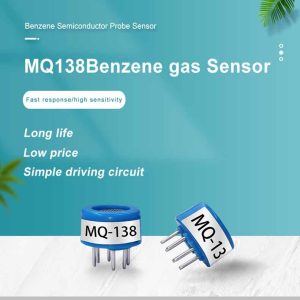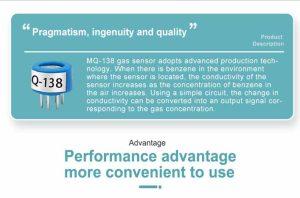-
Advancing Air Quality Monitoring: The Key Role of Gas Sensors
- Air pollution is a global environmental challenge that affects the health and well-being of millions of people worldwide. With the rapid urbanization and industrialization of many regions, the concentration of harmful gases and pollutants……
- Chat Online
-
Description
Air pollution is a global environmental challenge that affects the health and well-being of millions of people worldwide. With the rapid urbanization and industrialization of many regions, the concentration of harmful gases and pollutants in the air has reached alarming levels. To address this issue, advanced air quality monitoring systems have emerged as crucial tools for assessing and managing air pollution. Gas sensors play a key role in these systems by detecting and quantifying various gases and pollutants in the atmosphere. In this article, we will explore the importance of gas sensors in advancing air quality monitoring and discuss their applications in different sectors.

Understanding Gas Sensors:
Gas sensors are electronic devices designed to detect and measure the concentration of specific gases or volatile organic compounds (VOCs) in the air. They work based on various principles, including electrochemical, semiconductor, and optical sensing. Gas sensors consist of a sensing element, which reacts with the target gas, and a transducer that converts the detected signal into an electrical output. The concentration of the target gas can be determined by analyzing the electrical response of the sensor.
Benefits of Gas Sensors in Air Quality Monitoring:
Real-time Monitoring: Gas sensors provide real-time data on the concentration of various gases and pollutants in the atmosphere. This enables authorities to promptly identify pollution hotspots, assess the effectiveness of pollution control measures, and make informed decisions regarding public health and environmental policies. Real-time monitoring also helps in identifying and addressing sudden changes in air quality, such as industrial accidents or wildfires.
Accuracy and Selectivity:
Gas sensors offer high accuracy and selectivity in detecting specific gases and pollutants. They can differentiate between different types of gases and precisely measure their concentrations, even at low levels. This information is invaluable in understanding the sources and trends of air pollution, as well as evaluating the effectiveness of emission reduction strategies.
Portable and Versatile:
Gas sensors are available in various sizes and formats, allowing for portable and versatile air quality monitoring solutions. They can be deployed in stationary monitoring stations, wearable devices, drones, or even integrated into smartphones. This flexibility enables monitoring in different environments, such as indoor spaces, urban areas, industrial sites, and remote regions with limited infrastructure.
Early Warning Systems:
With their ability to provide real-time data, gas sensors can contribute to the development of early warning systems for air pollution events. By continuously monitoring air quality parameters, any sudden changes or exceedance of pollutant thresholds can trigger alerts, enabling authorities to take immediate actions and warn the public. This proactive approach can help prevent adverse health effects and reduce the impact of pollution episodes.
Applications of Gas Sensors in Air Quality Monitoring:
Urban Air Quality Management: Gas sensors are extensively used in urban areas to monitor air quality and assess the impact of traffic, industrial activities, and urbanization on pollution levels. They measure pollutants such as nitrogen dioxide (NO2), ozone (O3), carbon monoxide (CO), sulfur dioxide (SO2), and particulate matter (PM), which are key indicators of urban air pollution. This information helps city planners and policymakers develop effective strategies for reducing pollution and improving public health.
Industrial Emission Monitoring:
Gas sensors play a vital role in monitoring emissions from industrial facilities, power plants, and manufacturing processes. They enable continuous measurement of gases such as volatile organic compounds (VOCs), sulfur compounds, and heavy metals. By monitoring these emissions, industries can identify sources of pollution, optimize their processes, and ensure compliance with environmental regulations.
Indoor Air Quality Assessment:
Indoor air pollution is a significant concern, as people spend a significant portion of their time indoors. Gas sensors can be used to assess indoor air quality and detect pollutants such as carbon dioxide (CO2), volatile organic compounds (VOCs), and formaldehyde. This information helps in identifying potential sources of indoor pollution, such as building materials, furniture, cleaning products, and cooking activities. Improving indoor air quality is essential for maintaining a healthy and productive indoor environment.
Personal Exposure Monitoring:
Gas sensors integrated into wearable devices or personal exposure monitors allow individuals to track their exposure to pollutants in real-time. These sensors can measure gases such as ozone, carbon monoxide, and nitrogen dioxide, providing users with personalized data on their exposure levels. This information empowers individuals to make informed decisions about their activities, such as choosing less polluted routes for commuting or adjusting indoor environments to reduce exposure.
Sensor Calibration and Maintenance:
Gas sensors require regular calibration and maintenance to ensure accurate and reliable measurements. Calibration is necessary to account for changes in sensor performance over time, temperature, and humidity variations. Proper maintenance practices are crucial to prevent sensor drift, fouling, or contamination, which can affect the accuracy of measurements.
Sensor Interference and Cross-sensitivity:
Gas sensors can be prone to interference from other gases, humidity, or environmental factors. Cross-sensitivity to different gases can also affect the accuracy of measurements. Developing sensor technologies with improved selectivity and reduced interference is essential for reliable air quality monitoring.
Data Management and Integration:
Managing and analyzing large volumes of data generated by gas sensors can be a complex task. Efficient data management systems and integration with other technologies, such as data analytics, artificial intelligence (AI), and IoT, are crucial for effective decision-making and optimizing air quality management practices.
Miniaturization and Cost Reduction:
Advancements in sensor miniaturization and cost reduction are essential for enabling widespread deployment of gas sensors in various applications. Smaller, more affordable sensors can be easily integrated into existing infrastructure, wearable devices, or handheld devices, expanding the coverage of air quality monitoring.
Conclusion:

Gas sensors play a crucial role in advancing air quality monitoring and management. Their ability to provide real-time, accurate, and selective measurements of various gases and pollutants is instrumental in understanding the sources, trends, and impacts of air pollution. Gas sensors find applications in urban air quality management, industrial emissions monitoring, indoor air quality assessment, and personal exposure monitoring. However, challenges related to sensor calibration, maintenance, interference, and data management need to be addressed for the widespread adoption of gas sensors. With continued research, innovation, and collaboration, gas sensors can contribute significantly to improving air quality, protecting public health, and fostering sustainable development.
-
Recommend:
-
-
Gas detectors are essential devices used to detect and moni…
-
Gas sensors are electronic devices that detect, measure, an…
-
Gas detectors are essential safety tools that detect the pr…
-
Where is the gas detector mainly used
Gas detectors are essential safety tools that detect and mo…
-
 : +86 155 8830 2704
: +86 155 8830 2704 : jxdziot@gmail.com
: jxdziot@gmail.com
